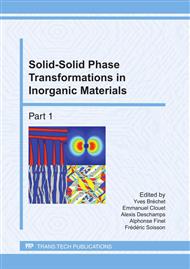p.178
p.184
p.190
p.196
p.202
p.208
p.214
p.221
p.229
Structural Transitions in a Co2NiGa Ferromagnetic Shape Memory Alloy
Abstract:
The development of ferromagnetic shape memory for practical applications needs to overpass brittleness issues, in addition to the control of the magnetoelastic domains. The Co-Ni-Ga system can provide adequate structural particularities to increase the ductility. This paper reports on structural observations of the martensitic transformation in a Co2NiGa alloy, in the as-cast and in plastically deformed state. Characterization has been performed before and after the heat treatment, using in-situ X-ray diffraction, optical and electron microscopy, as well as DSC measurements performed on heating and cooling of the samples. The observations show a β + γ two-phase structure that can be further influenced by quenching. The structural contribution on the deformation capacity of the alloys is analyzed, based on the changes in the pattern of transformation. Severe plastic deformation by cold rolling leads to the disappearance of the thermoelastic phase transformation.
Info:
Periodical:
Pages:
202-207
Citation:
Online since:
June 2011
Price:
Сopyright:
© 2011 Trans Tech Publications Ltd. All Rights Reserved
Share:
Citation:


